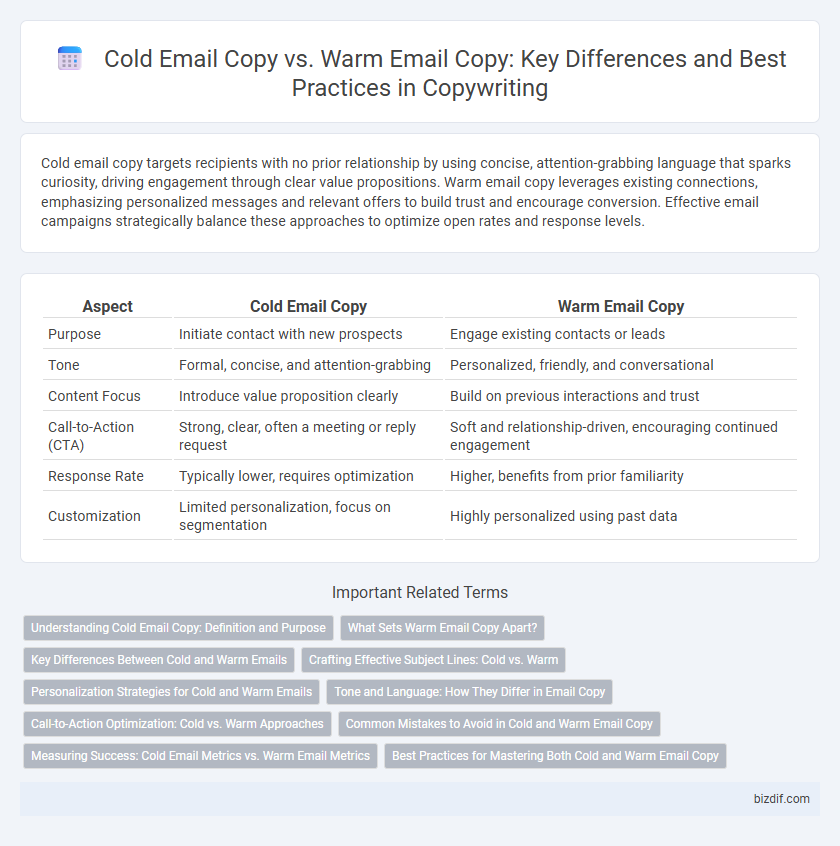Cold email copy targets recipients with no prior relationship by using concise, attention-grabbing language that sparks curiosity, driving engagement through clear value propositions. Warm email copy leverages existing connections, emphasizing personalized messages and relevant offers to build trust and encourage conversion. Effective email campaigns strategically balance these approaches to optimize open rates and response levels.
Table of Comparison
| Aspect | Cold Email Copy | Warm Email Copy |
|---|---|---|
| Purpose | Initiate contact with new prospects | Engage existing contacts or leads |
| Tone | Formal, concise, and attention-grabbing | Personalized, friendly, and conversational |
| Content Focus | Introduce value proposition clearly | Build on previous interactions and trust |
| Call-to-Action (CTA) | Strong, clear, often a meeting or reply request | Soft and relationship-driven, encouraging continued engagement |
| Response Rate | Typically lower, requires optimization | Higher, benefits from prior familiarity |
| Customization | Limited personalization, focus on segmentation | Highly personalized using past data |
Understanding Cold Email Copy: Definition and Purpose
Cold email copy targets unfamiliar recipients with the goal of generating new leads or initiating business relationships by delivering concise, compelling value propositions. It focuses on grabbing attention quickly through personalized subject lines and clear calls to action, overcoming the recipient's initial skepticism. The purpose is to establish credibility and spark interest without prior contact, differentiating it from warm email copy that builds on pre-existing connections.
What Sets Warm Email Copy Apart?
Warm email copy leverages existing relationships or prior interactions, making its messaging more personalized and contextually relevant to the recipient. It often includes references to past communications or shared interests, enhancing trust and engagement rates compared to cold email copy. By addressing known pain points and building on established familiarity, warm email copy consistently achieves higher open and response rates.
Key Differences Between Cold and Warm Emails
Cold email copy targets recipients with whom there is no prior relationship, requiring a clear, concise message that quickly establishes relevance and trust to boost open and response rates. Warm email copy, sent to prospects who have engaged previously or shown interest, leverages personalized content and references prior interactions, fostering stronger connections and higher conversion potential. Key differences include tone, personalization level, and call-to-action emphasis, with cold emails prioritizing introduction and value proposition, while warm emails focus on relationship-building and tailored offers.
Crafting Effective Subject Lines: Cold vs. Warm
Cold email subject lines must capture attention quickly by using concise, curiosity-driven phrases that encourage opens without prior relationship context. Warm email subject lines benefit from personalization and familiar tone, leveraging previous interactions to build trust and relevance. Crafting subject lines that align with the recipient's stage in the communication funnel significantly boosts open rates and engagement.
Personalization Strategies for Cold and Warm Emails
Cold email copy demands hyper-targeted personalization based on thorough research, including prospect demographics, pain points, and recent activities to establish relevance and credibility. Warm email copy benefits from referencing prior interactions, shared connections, or previous conversations to build trust and deepen engagement. Leveraging dynamic content and segmentation tools enhances personalization, increasing open rates and conversion metrics across both cold and warm email campaigns.
Tone and Language: How They Differ in Email Copy
Cold email copy uses a more formal, concise tone with clear value propositions to engage recipients unfamiliar with the sender, often avoiding casual language to build initial trust. Warm email copy adopts a conversational, personalized tone leveraging prior interactions or shared connections, using friendly language that fosters rapport and encourages a response. The strategic use of tone and language in each type directly impacts open rates, click-through rates, and overall email campaign effectiveness.
Call-to-Action Optimization: Cold vs. Warm Approaches
Cold email copy requires concise, persuasive calls-to-action that create urgency and clearly demonstrate immediate value to capture attention from unfamiliar recipients. Warm email copy benefits from personalized CTAs that leverage existing relationships, encouraging engagement through tailored offers or next steps that resonate with prior interactions. Optimizing CTAs for cold emails focuses on clarity and directness while warm email CTAs prioritize relevance and rapport to drive higher conversion rates.
Common Mistakes to Avoid in Cold and Warm Email Copy
Common mistakes in cold email copy include overly generic messaging, lack of personalization, and unclear calls-to-action, which lead to low response rates and high unsubscribe rates. In warm email copy, errors such as neglecting to reference past interactions, being too sales-driven too early, and failing to provide relevant value can reduce engagement and damage customer relationships. Both cold and warm email copy require precise targeting and tailored content to enhance open rates and conversion metrics effectively.
Measuring Success: Cold Email Metrics vs. Warm Email Metrics
Cold email metrics focus primarily on open rates, response rates, and conversion rates to assess initial engagement with unfamiliar recipients, highlighting the challenge of breaking through cold leads. Warm email metrics emphasize click-through rates, lead nurturing effectiveness, and customer retention rates, reflecting ongoing relationships and higher trust levels. Comparing these metrics allows marketers to tailor strategies by understanding how different audiences interact with cold versus warm email campaigns, optimizing overall email marketing effectiveness.
Best Practices for Mastering Both Cold and Warm Email Copy
Crafting effective cold email copy requires personalized subject lines, concise messaging, and clear calls to action to capture interest from unfamiliar prospects. Warm email copy excels by leveraging prior interactions, using a friendly tone and relevant references to build rapport and prompt engagement. Mastery of both involves segmenting audiences accurately and continuously testing messaging to optimize open and response rates.
Cold Email Copy vs Warm Email Copy Infographic

 bizdif.com
bizdif.com